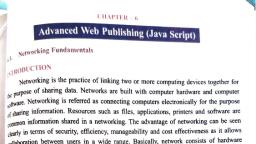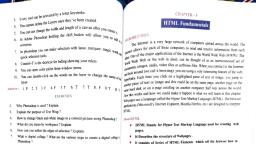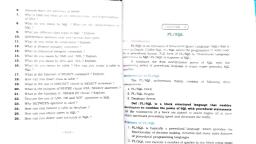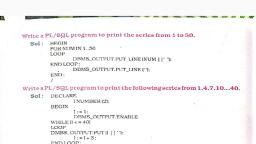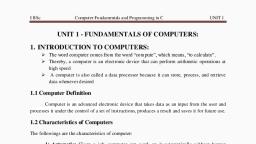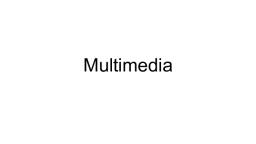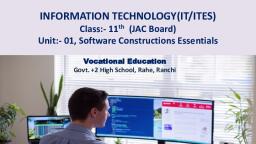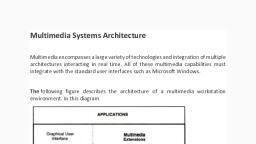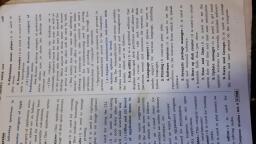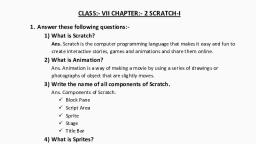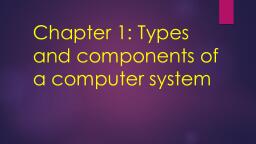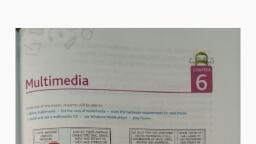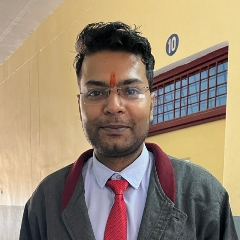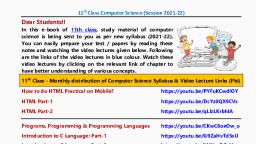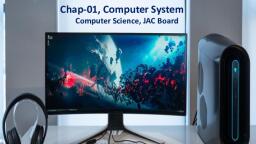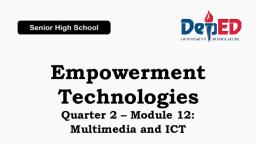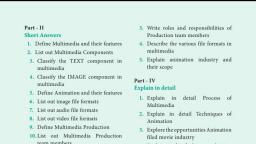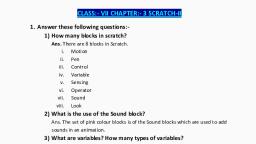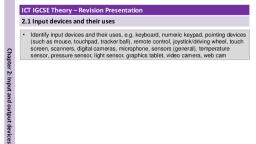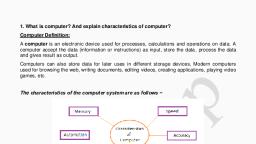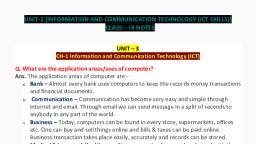Page 1 :
( If APTER 7, , Multitncdia Applications, (Sound and Video Editing), 7.1, , Sound :, , Sound is a fonn of energy. It is made when air molecules vibrate and move in a, pattern called wave, or sound waves. Sound is a type of wave that is produced by, vibrating object and that travels through matter as longitudinal wave. Sound needs a, medium to travel., , by:, , For human beings, sound is one of the most important ways to communicate, , a), , Expressing himself through speech., , b), , Obtaining information through listening., Sound allows more complex information transfer easier than visual impression., , 7.1.1 The Physical Components of sound:, The sound wave can be broken down into a series of basic physical, characteristics. These are :, a), , Frequency : It is defined as the number of cycles or complete waveforms, that, occurs with in the period of 1 second., Frequency of Sound Waves, lflC..kn, , ....., , \V, , ~, , ', , fJli', , \, , J, , ~, , lllal: 11M ct-lid Sound, , Fig. 7.1 Frequency, , b), , Pitch : Pitch is relative highness or lowness of a tone or frequency. It is number of, cycles with in a second., , c), , Amplitude : Amplitude describes the loudness or softness of the sound that we are, , (24 1), , I, , (Computer Science-XI)
Page 2 :
li stening to. The loudness of a sound is mca~urc<l in decibel (dR ). We can hear at, levels 60 dB . Sound levels above 120 dn arc fe lt as discomfort., , -~, , Quieter, , '/, Louder, , Fig. 7.2 Amplitude, , 7~2, , Microphone :, , Microphone (or Mic) is a device, a type of transducer, which converts acoustical, energy (sound wave) into electrical energy (the audio signal). Different types of, microphone have different ways of converting energy but they all share one thing, , common: the diaphragm. This is a thin piece of material, such as paper, plastic or, aluminium, which vibrates when it is struck by sound waves. In a typical hand held rnic, like the one below, the diaphragm is located in the head of microphone. When diaphragm, vibrates, it causes other components in the microphone to vibrate. These vibrations are, converted into an electric current which become the audio signal., , Fig. 7.3 Microphone, , 7 .3, , Types of microphone :, There are different types of microphone. Most popular of these are :, , a), , Dynamic microphone., , b), , Condenser microphone., , (242), , I, , (Computer Science-XI), , ~
Page 3 :
a), , Dynamic, ·, ., microphone:, In a dynamic microphone, sound wave hit· a th.m metallic, diaphragm that is attached to a coil of wire. The diaphragm vibrates the coil in, response to the sound wave. A magnet that is positioned inside the coil produce, magnetic field. It is the motion of coil in the magnetic field which generates th e, electrical signal., CNN• II 14 ' ~ 1 1- ......, , ~-, , ......, -•", ~, , =~, , ', , Fig. 7.4 Dynamic Microphone, , Advantages :, •, , Rugged and able to handle high sound pressure levels, like those delivered by, kick drum., , •, , Provide good sound quality in all areas of microphone performance., , •, , They do not require a power source to run., , •, , They are relatively cheap., , Disadvantages :, •, , Generally not suitable for recording instruments with higher frequencies and, harmonics like violin., , b), , (243), , Condenser microphone : Condenser microphone use a pair of charged metal, plates, one fixed (the back plate) and one movable (the diaphragm), forming a, capacitor. When a sound wave hits the diaphragm, the distance between the two, plates changes which produces a change in electrical characteristics called, capacitance. It is the variation of the spacing which produces the electrical signal_, corresponding to the sound picked up. These require a power source, to charge the, plates. This is usually done using a battery., , I (Computer, , Science-XI)
Page 4 :
.._.._,, , i;;;::?~, , et-~ti. . 4 •""1!.....t'i, , ~ ,., , \ =;: ,, , Fig. 7.5 Condenser Microphone, , Adv~ntages :, •, , The diaphragm assembly is light as compared to that of dynamic microphoae., Therefore these are more efficient and are capable of capturing a range of hial, l, frequency., , •, , They can be small in design., , •, , They have better high frequency response characteristics., , nis2dvantages :, , •, , These are more complex than dynamic microphone and are affected, extremes of temperature and humidity., There is a limit to the maximum signal level the electronics can handle., , •, , They are more expensive., , •, , 7.4, , ff, , Microphone Characteristics:, , Every microphone has a property known as directionality/ polar. This describes tp, microphone's sensitivity to sound from various directions. There are varieties of, directional pattern found in microphone design including:, a), , Omni directional, , b) · Bi-directional, c), , Cardioid, , d), , Hyper cardioid, , (244), , I, , (Computer Science-XI)
Page 5 :
Omni direct ional : These mi cropho nes capture sound equally from all directi ons., n muS t, They are useful for captur ing ambi ent noise and situations where the mic positio, remain fixed while sound source is moving like in play., , }, , I, , I, , I, , I, , I•, , Fig. 7.6 Omni Directional, , Bi-directional : These microphones use a figure of eight pattern and pick up sound, an, equally from two opposite directions. One possibility of using such pattern would be, interview with two people facing each other (with the mic betwe en them)., r, , x_~, ,,..,., , I, , .., .... /\'!;~, , W'I, , t~, , I·, , --I, , ., , . l-y\..-.. ~, , ~ ./ ,, , "-./'-, , I, , ~, , -~, , I.._...___~ ...-,,-·, ..., , ,, , Fig. 7.8 Bi-Directional, , (245) f (Comp uter Science-XI), , 1, , = f- l•, , I, , r ,
Page 6 :
\.', , ', which is the type of pick up pattern, Cardioid : Cardioid means 'heart - shaped, , · as', the front, but to. a lesser extent the side, these mic uses. Sound is picked up mostly from, e. Hand held mie s are usu ally cardioid., welJ. The cardioid is a very versatile microphon, , -~ /, , \ .,, :--1".,.,,,,,...-. 'Y', \, ....., , - l--4 -\,-t- --f- -+-- t, , -~, , .____, , ., , ..., I, , \, , " ·1-·., , ../\•'\/, , ., , ,, , __ ...,..,.,.,.,..Y, , Fig. 7.9 Cardioid, , eliminates mo st sound from sides and, Hyper cardioid : It is very directional and, a subject or direction whe n there is a lot, rear. They are used for isolating the sound from, to keep the sound consistent. If mic does, of ambience noise. But you need to be careful, audio., not stay pointed at the subject you will lose the, , \, , '~, , \, , !, , - 1, ', , .· ,-J-1·, , ., , I ....., -, , I",£, , ", , ~-✓·\, , ,., , \ \, , ., , t - ,___..., , /, 'I.., l, /, I,, .._ L,, ,\"1 /, -.I, /'', , ~, , I, , .~., , -- \, , I, , ,. // /, .,, , -, , Fig. 7.10 Hyp er Ca rd ioid, , (246) f (Computer Science-XI)
Page 7 :
, • 7.5, , Sou ndtrack :, Sound pl ays, , ·., ., •, very 11npo1tant, role makmg, our ex perience, of someth'mg comp 1ete., Though we might think film as an essentiall y visual ex perience, but we can not und er, estimate the importan ce of film sound., c, , The term so11ndtrack can refer to several things, depending on use. In broadeSI, se,rse it simply means anything you hear in the movie Le. sound effects, dialog, music, , etc., , The entire soundtrack is comprised of three essential ingredients, which mu 5t be, mixed and balanced so as to produce the necessary emphases which in turn create desired, effect., , •, •, •, 7.6, , The human voice (dialogue), Sound effects, Music (background sound), , Sound Editing :, , Sound editing is an art of producing greaf quality sounds for IlllXlilg,, implemen tation and processing. In simple words, sound editing is a laborious task of, making noisy and lousy recordings sound good. Sound editing is not just cleaning up bad, recordings. Some creative processes include:, a), , Dialogue editing: Fine - tuning lines spoken by actors in case of speech, defects., , b), , Dubbing: Re-recording dialogue in case of unsalvageable audio recording ., , c), , Sound design: Enhancing original audio with sound effects and filters., , d), , Music editing: Editing or synchronizing a soundtrack to events in the film., , e), , Mixing: Finely adjusting the levels, equalization, and dynamics of all the, tracks, in a program to focus attention on important audio cues and dialogue,, to make the other sound effects, ambience, and music tracks blend together, seamlessly., , Sound editing is done using software. These software let you record and edit, music, voice and other audio recordings. Some popular sound editing software are, Acoustica Basic edition, Audacity, wavepad etc., , (247), , I, , (Computer Science-XI)
Page 8 :
Midn,: Console :, , 7. 7, , A mixing con.fole is an electronic device for combining sound of many diffe~, audio signals. Mixing consoles are used in many applications, including recor/"', studios, public address system, night clubs, broadcasting, film post production etc. •ng, , A typica l, simple application combines signals from microphones on stage into, ampli_fier that drives one set of loudspeakers for the audience. Mixer often classified ;, their mput and output capab1ht1es. For example, a 32 X 8 mixer would have 32 individual, channel input and 8 main output channel. More professional boards have many more inJ)Ut, and output capabilities besides the main I/O's., , Fig. 7. 11 Mixing Console, , 7.8, , Video Editing :, , Vuleo editing is the process of manipulating and rearranging video shots to, create a new work. Editing is usually considered to be one part of the post - production, process. Other post - production tasks include titling, colour correction, sound mixing etc., , In general terms video editing means :, •, , Rearranging video shots., , •, , Adding or removing section of video., , •, , Creating transition between clips., , •, , Applying colour corrections, filters., (248), , I, , (Computer Science-XI)
Page 9 :
- ~~, , '"'·, , . f.--;; ,;J:.,W.,', , 7.8.1 Goals of Video Editing :, , The , ideo editing is needed due to certain rca.. 0 11,. Th cst an! :, •, , You can remove unwanted footage., , •, , You shoot several versions of a shoot and among those you can select thc bcSt, one ., , •, •, 7.9, , Using video editing, you can add several effects, sound to your vi deo., You can give your video a particular 'angle' or viewpoint on a certain agenda., , Types of Video Editing :, , There are several different ways to edit video and each method has it's own, advantages and disadvantages. Some commonly used methods are:, a), , Linear editing, , b), , Non linear editing, , c), , Film splicing, , (a) Linear editing : Linear editing was the original method of editing electronic, video tapes. In linear editing, video is selectively copies from one tape another. That's, why it is also called tape to tape editing. It requires at least two video machines connected, together - one act as the source and other is the recorder. The basic procedure is :, i), , Place the video to be edited in the source machine and a blank tape in recorder., , ii), , Press play on the source machine and record on the. recorder., , The idea is to record only those parts of the source, you want to keep. In this way, the desired footage is copied in the correct order from the original tape to new tape., , source \ICR, 1, , W"iftlNI\CR, , 2, , 3, , Fig. 7. 12 Linear Editing, , This method is called linear editing because it must be done in a linear fashion,, means, starting with the first shot and working through to the last shot. The linear editing, , (249), , f, , (Computer Science-XI)
Page 11 :
broadcast quality., , made changes hundred times over without starting all over again as in, can, You, ., editing., video, lmear, (c) Film Splicing: Technically this is not video editing, it's film editing. But it was, h b ·s of all video, 1, ., • pictures, the. .first way to ed·t, ally 1t. forms t e asi ·, conceptu, and, moving, ed1tmg., , Traditionally, film is edited by cutting sections of the film and rearranging. or, th, discarding em. The process is very straight forward and mechanical. A splicing machme, allows film footage to be lined up and held in place while it is cut or spliced together., , Fig. 7.14 Film Splicing, , 7.10, , Role of Video Editor:, , A video editor is a highly skilled person who edits movies or videos. Video editor, are general ly responsible for editing and assembling recorded raw material into a suitable ,, finished product ready for broadcasting. The material may include camera footage,, dialogue, sound effects, graphics and special effects., , The editor may be the part of team and they will usually work closely with, director to achieve the desired end result. The key responsibilities of a video editor, are:, •, , Edit raw footage content for producing film and ·video., , •, , Perform video and audio editing based on story sequence and continuity., Cut video sequences effectively to ensure the scenes are seamless and flow, , •, , logically., , (251), , I, , (Computer Science -XI)
Page 12 :
~,,, •, , Works closely with producers and directors durin g producti on., , •, , Review the scri pt to better understand th e video producti on requirements., , •, , Perfonn all editing work including inserting music, sound effects, story, boarding etc., , •, , Review all edited tapes to identify any issues and recommend changes as, necessary., , 7.1 1, , •, , Discuss with directors and producers about video layouts and editing styles., , •, , Develop post - production models for films., , •, , Organize video screenings for directors and producers to get their feedback., , Video Casette Recorder (VCR) :, , A video cassette recorder 'VCR' is an electromechanical device that records, analog audio and analog video from broadcast television or other source, on a video, tape that can be viewed at any time., A video cassette recorder is commonly used to record television programs, broadcast over the air or by the cable, and to playback commercially recorded cassettes on, a television set. Most VCRs have fast - forward and reverse controls and a timer that, enables television programs to be recorded automatically. They can record a program on, one television channel while a viewer watches a program on another channel on same, television set., , In VCR, the magnetic tape inside the VHS tape progresses above a recording/, playback head at a constant speed. It permits the transfer of video signal from or to the, tape. These signals are recorded on the tape in diagonal tracks. The stored video signal is, sent to the television for viewing. Some of the VCRs can erase the tapes prior to recording, on them;· so that better playback quality is meet out., VCRs are less expensive than other electronic devices., , Fig. 7.15 VCR, , (252), , I, , (Computer Science-XI)
Page 14 :
3., , ., , Now "c lick he~ to browse fo r video and photo" in the story board pane., , -·----, , •• --, , ... ., ... . ., ·-.....·---., , .............., , --, , -, , --·-·, , .., , ,,..1,r1, , ,c, , ... II:, , ·----·, >-, , ..... . -, , ::, , ,~ ;. r-, , -, , •, ~, , ~-, , P.'I, , CIiek hm for adding Video, f§ Picture, , 12, , ,, , ,, , _, , u ·. ,,.,;, , c. •, , ,,, , -, , • ·, , Et, , Fig. 7.1 6 Adding videos to Movie Maker, , 4., , Add videos and photos dialog will pop up on the screen. Now locate your photo, and video clips by clicking each and then click open button., , 5., , The selected clips will be added into timeline. In the final movie, the clips will, show in the same order as they are listed in the story board pane. You can rearrange, them by clicking and dragging., , 6., , You can add animation to the movie. For adding it, first select the clip in, storyboard pane., , 7., , Now click Animation tab and select desired animation. Movie Maker will show its, effects in the preview pane., , 8., , You can add music, by clicking Add Music option under Home tab., , 9., , In the Add Music dialog, locate the desired audio file and click on open., , 10., , You can add Caption to your clip, for adding caption select the clip you want to add, caption., , 11., , Click Home tab, then click caption option., , (254), , I, , (Computer Science-XO
Page 15 :
12 ·, 13 ·, 14 ·, , can type the text using Text, It will add the text place hold er on t'he clip where you, tool., command . You can nam e th e, Now click File tab and then click Save Proj ect As, ve., project and save the proj ect fil e on computer hard dri, Proj ect command., To open the project click File tab then click on Open, , •, •, •, •, •, •, , SUtVI MARY, molecules vibrates and, Sound is the fonn of energy, which is made when air, move in a pattern called wave., Sound has intensity, frequency and duration., ., Range of human hearing is with in 20Hz to 20000Hz, l energy into electrical, Microphone is a device, which converts acoustica, energy., r microphone., Microphone can be dynamic microphone or condense, in the movie - sound, The term soundtrack simply means everything you hear, effects, dialog and music., , •, •, •, •, •, , fast enough that it looks, A video is actually a series of still images, changing, like continuous motion., ranging video shots to, Video editing is the process of manipulating and rear, give desired look and feel to a video / film., rded raw material into a, Video or film editor is responsible for assembling reco, finished product suitable for broadcasting., ier Pro, Pinnacle Studio,, Popular video editing softwares are: Adobe Prem, Windows Movie Maker etc., Non Linear Editing, Film, Different types of video editing are: Linear Editing,, Splicing., , •, •, , Film splicing is not video editing, it's film editing., in sequential man ner from, Linear editing is the process of assembling footage, start to finish., , •, •, , (255), , I, , for home entertainment., A VCR is a general electromechanical device used, enables you to create, Window Movie Maker is a feature of Windows that, home movies and slide shows on your computer., (Computer Science~XI)
Page 16 :
EXERCI SE, , Q.1 What is sound ? What are its prope11ies ?, Q.2 What are microphones ? Explain its working., , Q.3 What is the difference between omni directionaJ and bi-directional microphone?, Q.4 What do you 111ean by sound editing ? Explain., Q.5 What is video editing ? Explain., Q.6 Why we need video editing ?, Q. 7 What are the different types of video editing ?, , Q.8 Explain the role and responsibilities of video editor., Q.9 Explain the working of VCR., Q.10 " 'rite short note on :, •, , Windows Movie Maker, , •, , Linear Editing, , •, , Non Linear Editing, , •, , Hyper Cardioid Mic

